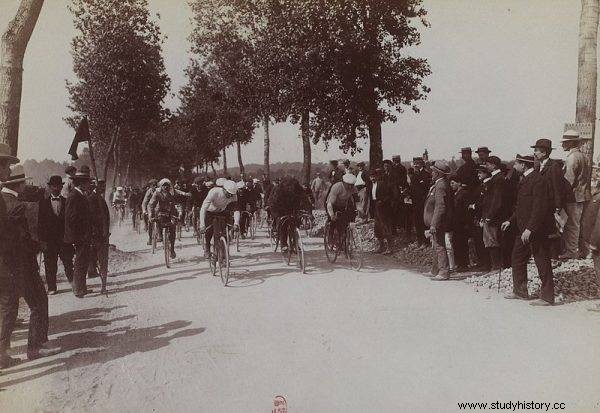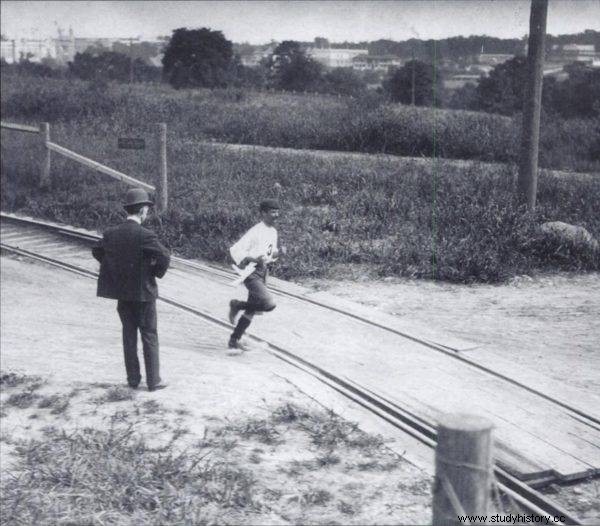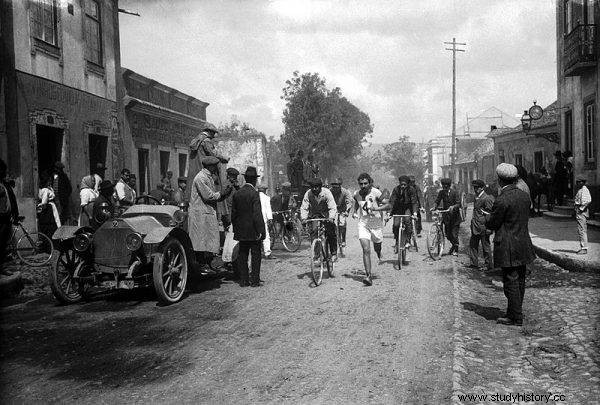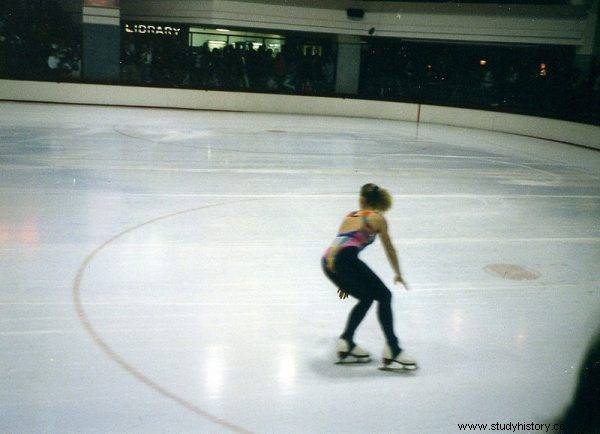Ayrton Senna, the legendary Formula 1 driver, once said that winning second is actually being the first to lose. Because real athletes train to win. They want to go down in history. It is good if in the pursuit of victory one catches good solutions. Worse, if they achieve triumph at the expense of principles, health or even life.
It was Saturday, July 18, 1903. A crowd of onlookers gathered along the streets of Paris. Everyone wanted to see Maurice Garin - a chimney sweep by profession, a cyclist by passion - become the first ever winner of the Tour de France. The 30-year-old, born in Valle d'Aosta, gave no chances to his rivals and had almost three hours advantage over Lucien Pothier, who was second in the general classification. It was a declassification.
The premiere "Big Loop" turned out to be a great success. Henri Desgrange, who published the sports magazine "L'Auto", hit the spot with his idea. The fans followed the race with great interest, and at the same time willingly paid for the next issues of his magazine, which described the rivalry in detail. The circulation and profits grew, the competition was lagging behind, so the event was organized periodically.
A year later, 88 daredevils entered the starting line. Everyone dreamed of the final triumph, but Garin was considered the favorite. The route, divided into six stages, gathered millions of French people who were energetically cheering for their pets. Unfortunately, the limit of fan love was exceeded, and the people, divided into several camps, proceeded to extremely tactless acts.
The support of one cyclist was associated with the harm of the other. For example, one of the participants was treated to a drink in which a laxative was dissolved . I don't think you need to explain what happened next. Henri Cornet, the winner of the race, was invited to a meal at one of the stages. He had received a chicken which his hostile gentleman had stuffed with veronal. A few minutes after the meal, Cornet fell into a roadside ditch and fell asleep. He was saved by the consciousness of his guardians, who found him, revived him and mobilized him to continue driving.

The premiere "Big Loop" turned out to be a great success. Henri Desgrange, who published the sports magazine "L'Auto", hit the spot with his idea. The fans followed the race with great interest.
Fans threw wine bottles at opponents, sawed bicycle frames and spread nails along the route. But the cyclists were not saints either. They were also up. The aforementioned Maurice Garin in 1904 turned from a hero to zero. It is true that was the first one to report at the finish line, but six months later it became apparent that he had covered a large part of the route ... by train . Anyway, the first four of that edition cheated by force, so the final triumph went to Henri Cornet, fifth at the finish. Only he was trying to drive fair.
How not to get tired during a marathon?
A little over a month after these events, the Olympic marathon rivalry took place in the vicinity of Saint Louis. Hot weather meant that only 14 out of 32 participants covered the required distance. Some of them were helped in the last meters, because American regulations allowed for it. Oddly enough, the one who crossed the finish line was not among them first. His name was Fred Lorz, he worked as a coal delivery man and was an American. He became a new idol for the 10,000 people who sat on that day at the Francis Field stadium. Temporary - it is worth adding.
While Fred was receiving the congratulations, his teammate Tom Hicks was covering the last few meters. He was exhausted, hallucinating, and seemed unlikely to make it through to the end. Fortunately, at this difficult moment, several people helped him, including doctors. Tom returned to the living and quickly informed the judges that Lorz was struggling with the cramps after 15 kilometers and then - at about 32 kilometers - he had unexpectedly overtaken him. It also looked fresh and untouched by the hardships of the route. Where does this burst of energy come from at Fred?

A little over a month after these events, the Olympic marathon rivalry took place in the vicinity of Saint Louis. Hot weather meant that only 14 out of 32 participants covered the required distance. Some of them were helped in the last meters, because American regulations allowed it
It turned out that Lorz actually had problems in the first part of the run. So he decided to help himself and stopped a car passing by. He talked to the driver and jumped inside. The next 15 kilometers he rested in the passenger seat, passing his rivals. Hicks's account was confirmed by other marathon runners, so the "sly" Fred was disqualified. When asked later why he did this, he said:
I thought to myself that you should keep your body temperature the same. When the car broke down, I could only do it by continuing to run. And so I did.
So the Olympic championship in 1904 was awarded to Thomas Hicks. As it turned out later, he was also not playing clean:when he was exhausted and it seemed that he was about to leave the tour, his companions served him an energy drink consisting of brandy, chicken protein and strychnine. The use of such a "stimulant" was then forbidden . It does not change the fact that the medal was not taken from him.
Surprise with technology, beat with technology
The desire for victory and eternal glory meant that technological innovations were introduced into the sport, which, by definition, would little help in achieving the set goals. As with everything, also with innovations it was different.
The footwear that Adolf Dassler prepared for the representatives of West Germany for the final match of the World Cup in 1954 was a real revolution in football. The shoes had removable cleats that could be changed depending on the weather. During the match against the famous Hungarian "Golden Eleven", the Germans, unlike their opponents, could replace the plugs with longer ones and did not slide on the marshy grass. The solution brought tangible benefits and success:the team of coach Sepp Herberger defeated the Hungarians (3:2) and won the championship.
In the 1960s, a similar epochal event was the appearance of carbon or glass poles at athletics stadiums. The shock of the pole vaulters was considerable. Until now, they jumped on aluminum equipment, and before that, wooden and bamboo. The flexibility of the new pole meant that the players significantly improved their records so far.

During the match against the famous Hungarian "Golden Eleven", the Germans, unlike their opponents, could replace the plugs with longer ones and did not slide on the marshy grass. The solution brought tangible benefits and success:the team of coach Sepp Herberger defeated the Hungarians (3:2) and won the championship.
Dick Fosbury, the American high jumper, won the gold medal at the Mexico Olympics in 1968. During his rehearsals, he used a jump technique called the "flop". At the sight of her, competitors rubbed their eyes in amazement, but after a while they copied Dick's style.
Another competitor who changed his technique, significantly raised his sports level, surprised his rivals and jumped to the top of his discipline, was the Swedish ski jumper Jan Boklöv. The "V style" he used made jumps longer and safer for health. In the 1988/1989 season, Boklöv won the general classification of the World Cup. Experts on the subject made no secret of the fact that this was due to the innovative technique.
However, not all the solutions used by the athletes were good. The temperature above 30 degrees took its toll on the participants of the marathon run, which took place at the Olympic Games in Stockholm in 1912. The runners tried by all means to defeat their opponents and the hot aura. The most interesting way was presented by the first participant of the Olympic marathon in the history of Portugal, Francisco Lázaro, who smeared his body with wax just before the start.
Loud applause from the audience and treatments aimed at increasing the chances of a successful performance only temporarily overshadowed the heat that was pouring down from the sky at that time. The real pogrom began a few kilometers after the start. Every now and then more runners descended from the route. Some even fainted. Among them was Lázaro.

The runners tried by all means to defeat their opponents and the hot aura. The most interesting way was presented by the first Olympic marathon participant in the history of Portugal, Francisco Lázaro, who smeared his body with wax just before the start.
The wax with which he smeared his body was to reflect the sun's rays and bring closer the final triumph. In fact, however, it acted as a sealant:it caused serious disturbances in the water and electrolyte balance, preventing the Portuguese from sweating. This one, overheated, lost consciousness several times, and finally the doctors had to resuscitate him. With no effect. Francisco did not regain consciousness, becoming the first ever athlete to die during an Olympic competition.
Another Olympian, who wanted to win, was overpowered by the modern pentathlon player Boris Onishchenko. In 1976, during a fencing competition, one of the rivals caught a representative of the USSR in a sublime fraud. Boris installed a switch in his weapon that closed an electrical circuit with each press, causing the light that signaled the hit to illuminate. It is not known how many times a smart fighter has used this invention. For such modifications, he was disqualified for life, fired from his staff and - as a soldier - removed from the Soviet army.
The best way? Eliminating a rival!
The meanest way that can help you achieve sports success is to physically eliminate your opponent. Unfortunately, the history of sport knows such cases as well. In 1994, in Lillehammer, Norway, during the Winter Olympics, the fight of two of the best American figure skaters - Tonya Harding and Nancy Kerrigan - took place in an unprecedented non-sporting dimension. It all started on January 6, 1994 in Detroit.
Preparing for the next struggle, Nancy was descending from the ice sheet. Training went well. In order to get to the locker room, the skater had to go through a long corridor. There, an attacker armed with a telescopic baton was waiting for her. He lunged at the woman and dealt a few blows to her legs. The contestant fell. A few minutes later she was under the care of doctors. Fortunately, her legs were "just" bruised. However, this does not change the fact that Nancy Kerrigan had to withdraw from the start in the national championship. Those in her absence were won by ... her main competitor Tonya Harding. Coincidence? Well, not really.

Nancy Kerrigan had to withdraw from the national championship. Those in her absence were won by ... her main competitor Tonya Harding (pictured). Coincidence? Well, not really.
It was quickly established who was behind the attack. On behalf of Harding's ex-husband Jeff Gillooly and her bodyguard, Shawn Eckhardt, Nancy was attacked in preparation for the Olympics by a man named Shane Stant. Tonya knew everything. Initially, the federation decided to exclude her from the Olympic team. Later, however, the decision was reversed and the dishonest skater started in Lillehammer. The attacked rival managed to recover and also entered the Olympic surface. There the final clash took place, from which Nancy Kerrigan emerged victorious. She won an Olympic silver medal.
Tonya was only eighth. And it was actually the beginning of its end. When both contestants returned to the country, union activists disqualified Harding for life and fined her (over $ 100,000). The skater tearfully defended herself, claiming that she wanted to notify the FBI of her husband and his companions' plans, but that she was threatened with death. But no one believed her words.
Much more tragic was the idea of boxer Luis Resto and his staff, who at the start with Billy Collins Junior were preparing not only in the training room. The first blows of the lower-ranked Puerto Rican made a great impression on the American. Resto hit very hard and Collins's face swelled at an alarming rate. The duel, played in June 1983 in Madison Square Garden, New York, lasted 10 rounds. After it ended, the defeated father approached his son's rival to congratulate him on his victory. He then discovered that Luis' gloves were unnaturally hard. He immediately notified the competition commissioner, who ordered them to be checked.
It turned out that the Resto equipment was crafted - some material was removed from it. In addition, the bandages that wrapped the Puerto Rican's hands before the fight were soaked in plaster and his coach, Panama Lewis, was supposed to tinker with the gloves. This is why Collins Junior shouted during the fight that his opponent had fists like stones.
As a result of the fight, Billy had problems with his eyesight and ended his boxing career. Then things turned out swiftly. I'm sorry. Collins sought solace in alcohol, followed by depression, divorce, and a tragic death in a car accident.
Bibliography
- Grinberg, A. Parczewski, Olympics of athletes:volume 3 Saint Louis , Warsaw 2020.
- Collective work, Kronika Sportu , Warsaw 1993.
- Filek, Cards from the history of sport , Poznań 2012.
- https://historiasportu.info/2017/10/07/borys-oniszczenko-cwaniak-stulecia/
- Delimat, Film: The tragedy that rocked boxing , posted on YouTube channel "Thirteenth Round".
